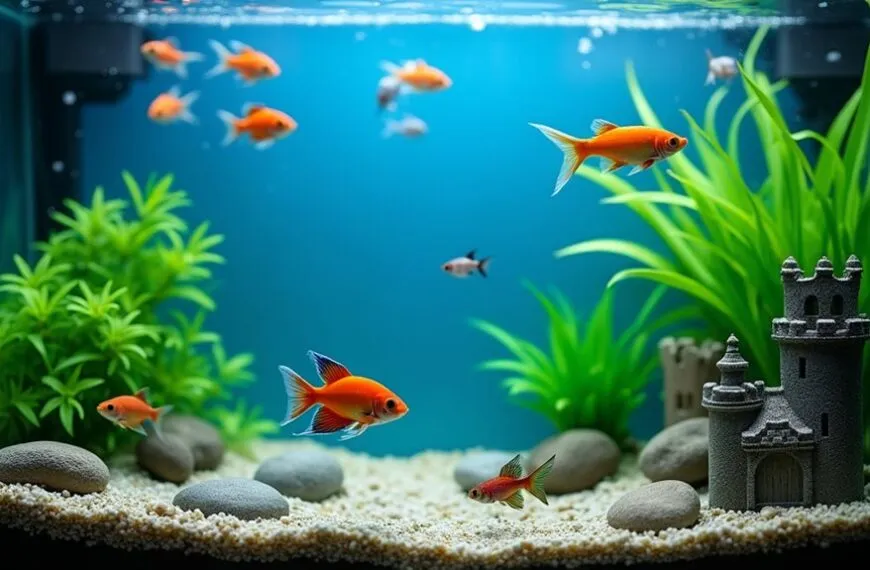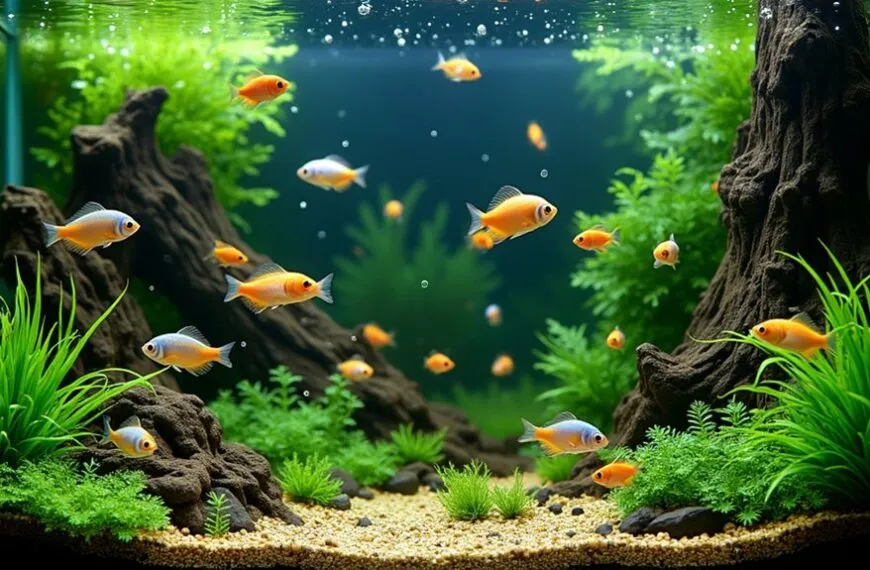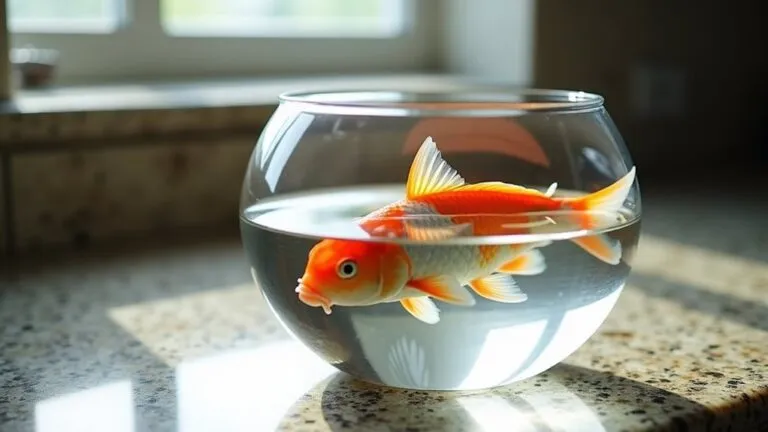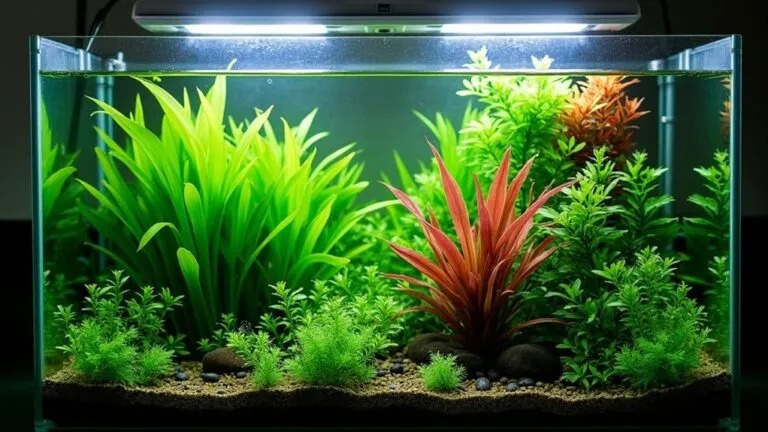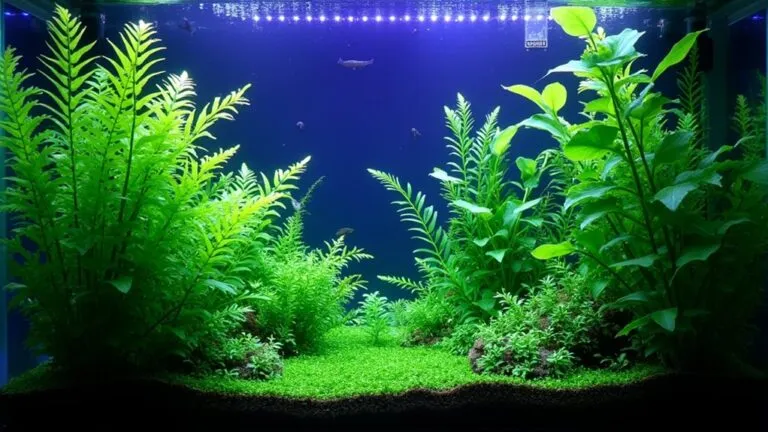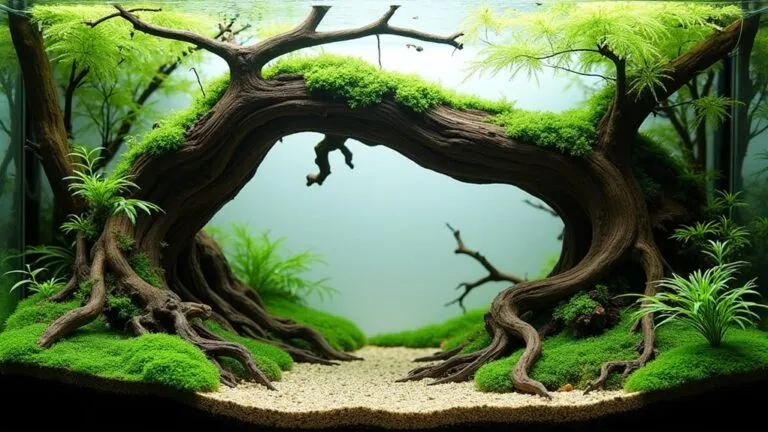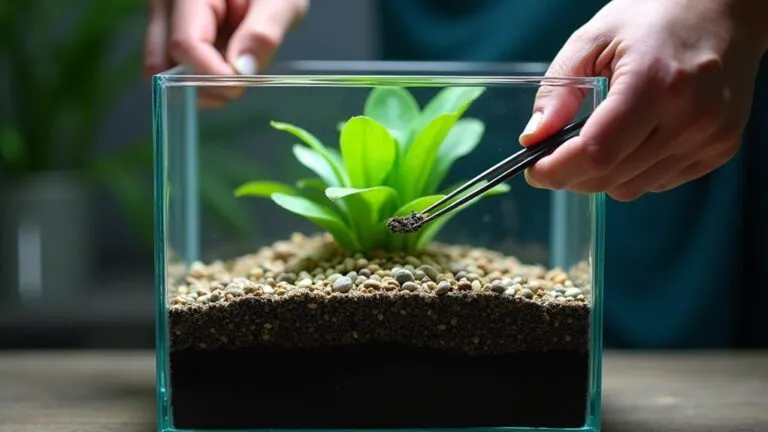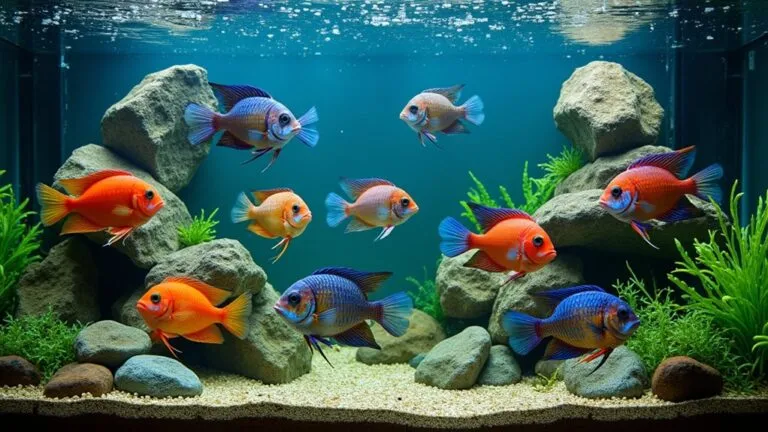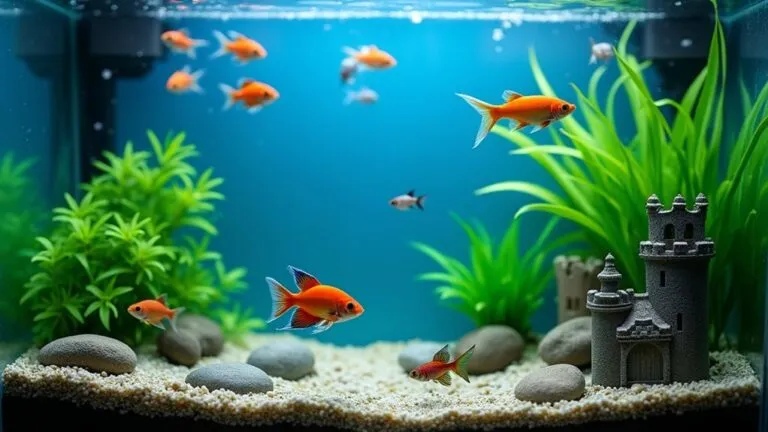Setting up your aquarium is a blast, especially with beginner-friendly fish like goldfish and bettas. Goldfish are resilient and grow quite big, so give them room. Betta fish add vibrant colors, but keep males solo—no fish brawls, please! Tetras are social little swimmers, perfect in groups, while guppies are colorful and easy to care for. Don’t forget about Cory catfish; they’re playful bottom dwellers. And let’s not overlook rasboras, known for their playful, lively spirit. You’ll find your perfect aquatic buddies in no time, and there’s so much more to discover about these fantastic fish!
Contents
Goldfish
When you’re looking for a beginner-friendly fish, goldfish are a fantastic choice due to their resilience and adaptability.
These little swimmers can grow between 12 to 14 inches, so you’ll need a minimum of 30 gallons per fish. It might sound like a lot, but it’s essential for their well-being. Goldfish are known to be quite the waste producers, which means regular water changes are a must to keep the tank clean and the fish happy.
Regular water changes help to maintain quality and control nitrate levels, promoting overall fish health.
Their omnivorous nature means they love a balanced diet! You can feed them spirulina algae, veggies, and low-protein foods to help them thrive.
Just remember, keeping goldfish in a single-species aquarium is best. They can display some aggression, especially if they feel their territory is threatened.
Maintaining stable water conditions is key to ensuring your goldfish live a long, healthy life.
Betta Fish
Betta fish are a stunning choice for beginners, boasting vibrant colors and impressive fins that catch the eye. You’ll quickly fall in love with their unique personalities and striking appearances.
These fish are easy to keep, but there are a few important things to know for their well-being. Maintaining proper water parameters is crucial for their health; for instance, the ideal temperature range is between 78-82°F to support their thriving condition, and consistent temperatures support fish health.
- Betta fish thrive in a minimum tank size of 5 gallons.
- Males need solitary housing, while females can live happily in groups.
- Provide them with high-quality food to keep them healthy and vibrant.
While bettas can be territorial, they can coexist with non-aggressive fish like tetras or corydoras in a community tank, but always keep an eye out to avoid conflicts.
Tetras
Tetras are a fantastic addition to any beginner’s aquarium, known for their vibrant colors and lively behavior. If you’re looking to create a small aquarium, these brightly colored fish can really make your tank pop! One of the most popular species is the neon tetra, famous for its stunning blue and red hues. They’re tiny, growing up to just 1.5 inches, and thrive best in groups of six or more, which makes them perfect social schooling fish.
Maintaining optimal water quality is essential for their health, so keep an eye on parameters such as pH and ammonia levels to ensure a thriving environment essential test parameters.
Tetras are easy to care for, especially if you maintain stable water conditions with a neutral pH between 7.0 and 7.8. Their low care requirements mean you can focus more on enjoying their antics rather than stressing over complicated needs.
Plus, they’re peaceful little guys, making them great community fish that get along well with others like rasboras and corydoras.
Just remember to do regular water changes and provide a varied diet of small flakes and live or frozen foods. Your tetras will reward you with their spirited swimming and vibrant colors, bringing joy to your aquarium and making it a delightful space for everyone!
Guppies
Guppies aren’t just pretty faces; they’re also super easy to care for, making them perfect for your first aquarium.
You’ll love watching these little livebearers bring new fry into the world, and trust me, they can multiply faster than you can say “fish tank”!
Plus, they play nice with others in a community tank, so you can create a colorful underwater party without much fuss.
Basic Care Requirements
When it comes to keeping vibrant and lively fish in your aquarium, guppies are a fantastic choice. These little gems not only bring color to your tank but also have easy care requirements that make them perfect for beginners.
To help you get started, here are a few essential tips:
- Tank Size: Aim for at least a 10-gallon tank to give your guppies space to swim and grow.
- Groups: Keep them in groups of 5-6. This reduces stress and encourages their natural schooling behavior.
- Water Conditions: Maintain a pH between 6.8 and 7.8, and keep the temperature between 74-82°F.
These small fish thrive with a varied diet, so don’t forget to feed them flakes, pellets, and some plant material now and then.
Regular maintenance is key to stable water conditions, which helps your guppies flourish. Remember, a happy guppy makes for a happy aquarium!
With a little effort, you’ll see these colorful fish swimming joyfully, bringing life and excitement to your small aquarium. So, roll up your sleeves and dive into the wonderful world of guppy care!
Breeding and Offspring
Breeding guppies can be an exciting aspect of aquarium keeping, especially since these fish are known for their prolific reproduction. Did you know that female guppies can produce 20 to 30 fry every 4 to 6 weeks? That’s a whole lot of little fish!
However, fry are born fully formed and can swim immediately, making them easy targets for adult fish. To ensure their survival, it’s crucial to create plenty of hiding spots in your tank.
If you’re looking to manage the population, consider separating males from females unless you want to breed. Adult males are usually smaller and flaunt more vibrant colors, while females are larger and a bit drabber. It’s like having a colorful party of fish!
To promote healthy growth in your fry, provide a varied diet. Finely crushed flakes and live or frozen foods are excellent options. This diet not only supports their development but also enhances their vibrancy.
Community Tank Compatibility
Creating a vibrant community tank can be a rewarding experience, especially with the addition of guppies. These small freshwater fish aren’t just colorful; they’re also incredibly adaptable, thriving in various water conditions. Guppies are peaceful species, making them great companions for other similar fish like tetras and rasboras.
When setting up your community tank, consider these points:
- Schooling Fish: Guppies enjoy being in groups of five or more, promoting a lively atmosphere and reducing stress.
- Compatible Tank Mates: Their non-aggressive nature allows them to coexist happily with other peaceful species.
- Care in a Community Tank: With an omnivorous diet, they accept a variety of foods, making feeding a breeze.
As livebearers, guppies can reproduce quickly, so keeping a ratio of one male to two or three females can help manage their breeding effectively.
This way, you can appreciate their beauty without feeling overwhelmed.
With a little care and attention, you’ll enjoy the lively dance of guppies in your community tank, all while providing a nurturing environment for these delightful fish.
Cory Catfish
Cory catfish are a fantastic choice for beginners diving into the world of aquariums. These small, peaceful bottom dwellers typically grow to just 2-4 inches, making them perfect for community tanks. You’ll find they thrive best in groups of five or more, as their social nature helps reduce stress and encourages happier behaviors.
Imagine watching them scuttle around, exploring the tank together—it’s a joy!
To keep your cory catfish happy, provide a soft substrate. This protects their sensitive barbels, allowing them to forage for food without a hitch. Speaking of food, they’ve an omnivorous diet, meaning they’ll happily munch on sinking pellets, algae, and detritus.
Variety is key for their nutritional intake, so mix it up to keep them healthy.
Cory catfish are known for being hardy and adaptable, which makes them easy-to-keep fish for anyone just starting out. With their charming personalities and gentle demeanor, they’re sure to bring a smile to your face.
Rasboras
When it comes to adding a splash of color to your tank, rasboras are hard to beat!
With their vibrant hues and playful schooling behavior, these little fish not only brighten up your aquarium but also make it lively and fun to watch.
Plus, they’re super easy to care for, so you can enjoy their beauty without the stress of complex requirements!
Vibrant Colorful Varieties
Rasboras’ vibrant colors and lively behavior make them a captivating choice for any aquarium. These small freshwater fish come in various species, with the Harlequin rasbora being a popular favorite. Their stunning hues and active swimming patterns can truly brighten your tank and bring joy to everyone who sees them.
When you choose rasboras, you’re opting for great beginner pets that are both beautiful and easy to care for. Here are a few reasons why they’re perfect for your aquarium:
- They thrive in groups of six or more, enhancing their social nature.
- Rasboras are peaceful, allowing them to get along well with other fish.
- Their diet is simple, consisting of flakes, pellets, and occasional live foods.
You’ll appreciate that rasboras adapt well to different water conditions, making them stress-free companions.
Plus, their ease of care means you can focus more on enjoying your aquarium rather than worrying about the fish.
Whether you’re a seasoned aquarist or just starting out, these colorful swimmers will add a lively touch to your aquatic community.
Schooling Behavior Importance
Adding rasboras to your aquarium not only brings vibrant colors but also showcases their fascinating schooling behavior. These little fish thrive in groups of six or more, which is vital for their health and happiness.
When they swim together, they create a stunning display and feel safer, helping them evade potential predators. Plus, their peaceful temperament makes them a perfect fit for community tanks, allowing them to coexist with other friendly fish.
If you want to keep your rasboras happy, make sure to provide well-planted tanks with plenty of hiding spots. This setup mimics their natural habitat, encouraging their natural activity and ensuring they feel comfortable.
Watching them dart around in groups isn’t only entertaining but also a reminder of the beauty of nature.
For beginner aquarists, rasboras are a fantastic choice. They’re easy to care for and add a lively spirit to your tank.
Remember, the more, the merrier! So, gather a few friends for your rasboras and enjoy the delightful show they put on together.
Your aquarium will thrive, and you’ll have a front-row seat to nature’s own aquatic ballet!
Easy Care Guidelines
To keep your rasboras thriving, focus on their specific care requirements. These charming little fish are perfect for beginners and add a splash of color to your freshwater aquarium. Here are some easy care tips to ensure they flourish:
- Maintain a water temperature of 74-82°F and keep the pH between 6.0-7.5.
- Provide a varied diet including high-quality flakes, micro pellets, and the occasional live or frozen treat.
- Create a well-planted aquarium with hiding spots to give them a cozy environment.
Rasboras grow to about 2 inches and love to swim in groups of six or more, making them ideal for community tanks. Their peaceful nature means they get along wonderfully with other fish, like tetras and corydoras, so you can build a harmonious aquarium.
Regular water changes are essential to keep their habitat clean and healthy. By following these easy care guidelines, your rasboras won’t only survive but thrive, bringing joy and life to your aquatic space.
Frequently Asked Questions
What Is the Easiest Fish to Take Care of for Beginners?
For beginners, easy fish species like guppies and neon tetras thrive in basic fish equipment. They adapt to various beginner fish habitats, require minimal maintenance, and offer compatible fish varieties for a vibrant, low-maintenance aquarium.
What Are the Best Beginner Fish to Live Together?
Did you know that keeping peaceful species, like Neon Tetras and Guppies, can enhance your small aquarium’s harmony? These hardy varieties thrive in community tanks, ensuring compatibility among tank mates with similar feeding habits.
What Is the Easiest Fish Tank to Take Care Of?
The easiest fish tank to care for is a 10-gallon freshwater setup. Focus on filtration systems, water quality testing, and efficient cycling. Utilize low light plants and consider tank size for optimal betta fish care or goldfish.
What Is the Best Fish to Keep Alone?
Did you know that bettas can recognize their owners? For solo fish, choose a betta. Prioritize betta fish care with proper tank size, aquarium filtration systems, and a consistent fish feeding schedule to ensure their health.
Final Thoughts
So there you have it! Whether you’re drawn to the vibrant colors of Betta fish or the playful nature of Guppies, these beginner-friendly fish can bring joy to your home. Each one has its own charm, making your aquarium a little slice of underwater paradise. Just remember, caring for them is like riding a bike—once you get the hang of it, you’ll be cruising along! Dive in and enjoy the journey of fishkeeping!


